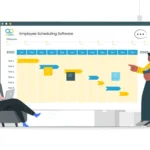Instances of employees failing to notify about their absence, known as “no call no show”, can be challenging. The performance of other employees may be affected too as they juggle their tasks along with those of the absent colleague. If not managed effectively, no call no show cases can impact the overall functioning of a business.
A “No Show, No Call” (NCNS) is when an employee is absent from scheduled work without informing the company. In simpler terms, it’s when someone doesn’t show up for their shift and doesn’t let the employer know through a call, email, or other communication.
To address recurring no call no show cases, it’s essential to have a systematic approach that minimizes it and ensures a smoother workflow. NCNS employees lead to an average productivity loss of 36.6%.
Dealing with no call no show situations is a part of managing a team, and it’s important to be prepared. Mistakes happen, and unexpected emergencies can arise. The U.S. Bureau of Labor Statistics reports that 2.3% of the nation’s workforce misses work due to injuries and illnesses.
To handle no call no show cases effectively, this blog outlines a few tips for you to consider.
What Does the law mention about No Call No Show?
In the United States, there’s no federal law specifically regulating no call no show policies, but most employers can terminate employees who miss work without notice. However, there are some exceptions. For example, in Washington State, employees earn paid sick leave and may not be required to notify their supervisor if they are absent due to serious illness or family care.
Certain situations, like employees covered by the Americans with Disabilities Act (ADA) or Family Medical Leave Act (FMLA) leave, or those under a union contract, may have different rules regarding no call no show.
You can create your own NCNS policy, but ensure that they don’t violate other labor laws, such as anti-discrimination laws. It’s best to consult with an employment attorney or the Department of Labor in your state to make sure your company is in compliance with employment laws.
Does a No Call No Show Cost You?
Without a no call no show policy, your company is susceptible to incurring unnecessary expenses. These include finding replacements for absent employees or compensating others for overtime work. Implementing a no call no show policy can lead to cost savings.
Here’s how no call no shows can impact your company financially:
- Overtime Costs: When an employee doesn’t show up, others may need to work overtime to cover shifts, increasing labor costs. As per ‘Absenteeism: The Bottom-Line Killer’ by Circadian, the annual cost of unscheduled absenteeism is approximately $3,600 for each hourly employee.
- Replacement Costs: Employing temporary or additional workers to cover for absent employees results in additional expenses. For long-term absenteeism, a full-time worker may be required on board to cover for the absent employee.
- Increased Absenteeism Costs: Without clear rules on no call no shows, employees may take advantage of the situation, leading to increased unplanned absences.
A no call no show policy helps reduce these costs by establishing clear rules and making employees aware of the consequences. When employees understand the potential repercussions of not showing up without notice, they are more likely to attend scheduled shifts.
Best Tips To Handle No Call No Show Situation
Tip #1: Have a no call no show policy
Having a clear NCNS policy is crucial to reducing and managing such situations. This policy should outline workplace rules, disciplinary actions for no call no show incidents, and acceptable reasons for such occurrences. These rules should be a part of your employee handbook.
Ensure your policy encompasses the following essential elements:
- Clearly outline what qualifies as a no-call no-show incident.
- Differentiate between excused and unexcused absences for clarity.
- Specify the disciplinary measures for instances of no-call no-show.
- Clearly state the number of excused no-call no-shows allowable before job termination.
- Define the proper procedures for requesting time off.
Tip #2: Implement an efficient attendance management system
An automated system for time tracking and attendance can be invaluable in identifying when someone is absent. This is particularly useful in large companies with many employees.
Time tracking software with a QR code can be useful in handling NCNS situations. QR code attendance systems offer various benefits such as
- Historical Data Analysis: Automated attendance systems can help in analyzing historical attendance data. This can identify patterns or trends in employees’ attendance behavior.
- Notification Alerts: Integrated notification systems can alert managers when an employee hasn’t scanned the QR code within a specified timeframe. This approach helps address potential NCNS situations by giving enough time to swap shifts etc.
Tip #3: Promote open communication among your employees
Encourage transparent dialogue with your employees. It helps in creating a culture where they feel at ease requesting time off or seeking assistance during personal challenges. This fosters better collaboration and team organization.
When employees feel free to communicate their need for time off or share any issues they’re facing, the number of NCNS situations diminishes. Building a foundation of trust through good and honest communication allows employees to explain any difficulties preventing them from coming to work.
Tip #4: Simplify Scheduling for Optimal Team Performance
Examine your scheduling process closely by considering the following questions:
- Is your current scheduling method user-friendly for employees to request time off?
- Does your scheduling system allow employees some influence over their work hours?
- Does your scheduling approach facilitate the easy indication of availability for employees?
If the response to any of these questions is no, you need to streamline your scheduling process. Create a schedule that accommodates your team and leaves enough room for last-minute changes. It allows easy access to daily or weekly work plans, preventing any confusion.
A job scheduling app centralizes all scheduling activities in the cloud, providing you and your team with any time, anywhere access. Some job scheduling apps integrate with attendance tracking features. Managers can monitor actual attendance against scheduled shifts, quickly identifying instances of no call no show.
Conclusion
The success of your business relies heavily on effective employee management, as one absentee can impact the entire team. Prevent the negative consequences of no call, no show situations by implementing a clear absence policy and developing contingency plans for uncovered shifts. To efficiently handle these challenges, consider leveraging automation apps that encompass features such as attendance management and job scheduling.
Utilizing the right tools ensures accurate scheduling without issues like double bookings or unexpected absences. These apps, equipped with comprehensive features like time and attendance tracking, job scheduling, etc. become invaluable in finding substitutes swiftly when needed.
For effective attendance management, and combating no call no show scenarios, consider switching to automated job scheduling software. You can explore the advantages of these tools by trying a 14-day free trial at www.allgeo.com


